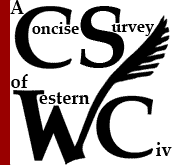Primary Sources for Chapter 14
A World Divided: The Early Cold War, 1945 to 1980
Study Guide | Art History | Links
The Truman Doctrine: The American President outlines a key policy toward the developing Cold War on 12 March 1947.
Content Question: What specific actions does Truman propose?
Analysis Question: What general policies does Truman suggest would be undertaken by America to support “free peoples”?
Evaluative Questions: How does this speech frame the ideological conflict between the two sides of the Cold War? How does this definition of American goals compare with those asserted by other presidents, e.g. Kennedy, Johnson, Reagan).
See also here, a study version here,
Elvis visits Nixon: The “King of Rock and Roll” meets the president in the White House to discuss reaching young people.
Content Questions: How does Elvis explain his interest in offering support to Nixon?
Analysis Question: What did Nixon mean by Elvis having to preserve his “credibility”?
Evaluative Questions: How ironic is Elvis’ offer considering his own superstar lifestyle? How does this meeting reflect the tensions within Western society at this time?
For more on this event see When Nixon met Elvis.
More sources about the Sixties, especially Vietnam protest and Civil Rights, are here.
Address to the UN General Assembly, 23 September 1960: Premier Khrushchev of the Soviet Union presents his side of the Cold War.
Content Question: What actions does he blame on the United States and NATO for damaging “peaceful coexistence”?
Analysis Question: How willing to work with the U.N., the U.S. and/or NATO does Khrushchev seem ?
Evaluative Questions: How could conflicts between NATO and Soviet versions of “freedom” be resolved?
The Kenya Africa Union is Not the Mau Mau: future president Jomo Kenyatta calls for independence.
Content Questions: What are Kenyatta’s complaints about British rule? What threatens Kenyatta’s attempt to organize and inspire the Kenyans?
Analysis Question: How would the British attempt to identify Kenyatts's K.A.U. with the “Mau Mau” hurt his movement?
Evaluative Questions: How do Kenyatta's calls for freedom compare to similar demands in Western history?
Address Before the American Society of Newspaper Editors: President Kennedy proposes lessons to be learned after the failure of the Bay of Pigs Invasion of Cuba.
Content Question: What are the clear lessons Kennedy says should be learned?
Analysis Question: Is there in this speech an apology, some assinging blame, or any explanation for the invasion’s failure?
Evaluative Questions: What tone does this speech set? How does this definition of American goals compare with those asserted by other presidents, e.g. Truman, Johnson, Reagan).
President’s Message to Congress about the Gulf of Tonkin Incident (2-4 August 1964) or here: Johnson justifies American commitment to South Vietnam.
Content Question: What reasons does Johnson state for increased American intervention?
Analysis Question: How does Johnson connect to larger issues of the Cold War and the Truman Doctrine (above)?
Evaluative Questions: What realistic options did America have to deal with communist expansion in Southeast Asia? How does this definition of American goals compare with those asserted by other presidents, e.g. Truman, Kennedy, Reagan).
See also: transcripts of phone discussions, video of LBJ on televsion (and here), and the some analysis.
Remarks at the Brandenburg Gate: Ronald Reagan defines the issues of the Cold War.
Content Question: What are the differences Reagan points out between the “West” and the Soviets?
Analysis Question: How does Reagan frame the issue as if the “West” had already won the Cold War?
Evaluative Questions: Did qualities of “faith,” “truth,” or “freedom” bring down the wall or other more definable actions? How does this definition of American goals compare with those asserted by other presidents, e.g. Truman, Kennedy, Johnson).
Other Sources:
Cold War International History Project <http://www.wilsoncenter.org/cwihp> archives many detailed documents about the Cold War, some untranslated.
European Union Internet Resources <http://guides.lib.berkeley.edu/european-union> organized by the University of California, Berkeley.
The Cold War Years
<http://www.history.army.mil/html/bookshelves/resmat/tcwy.html> the U.S. Military's website with useful sources under “published materials” and “archival materials.”
Cold War
<http://avalon.law.yale.edu/subject_menus/coldwar.asp> a small collection at Yale's Avalon Project.
Weapons of Mass Destruction
<http://www.photographyserved.com/gallery/Weapons-of-Mass-Destruction/56260> beautiful photos of the weapons of the Cold War.
Kim Phuc Phan Thi: Vietnam War Survivor: Testimony of girl burned by American napalm.
Primary Source Project Links
14. Kruschchev versus Nixon about Compeittion



